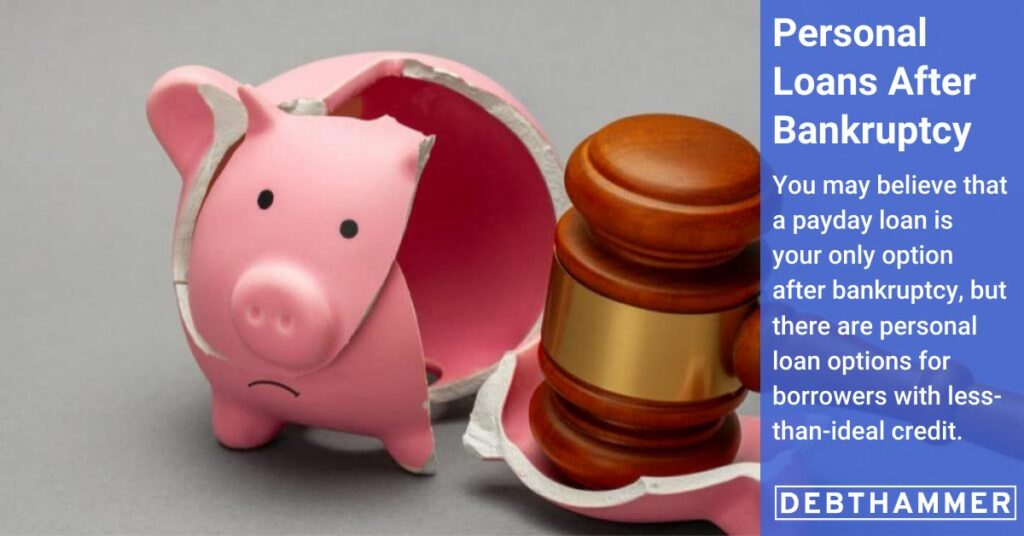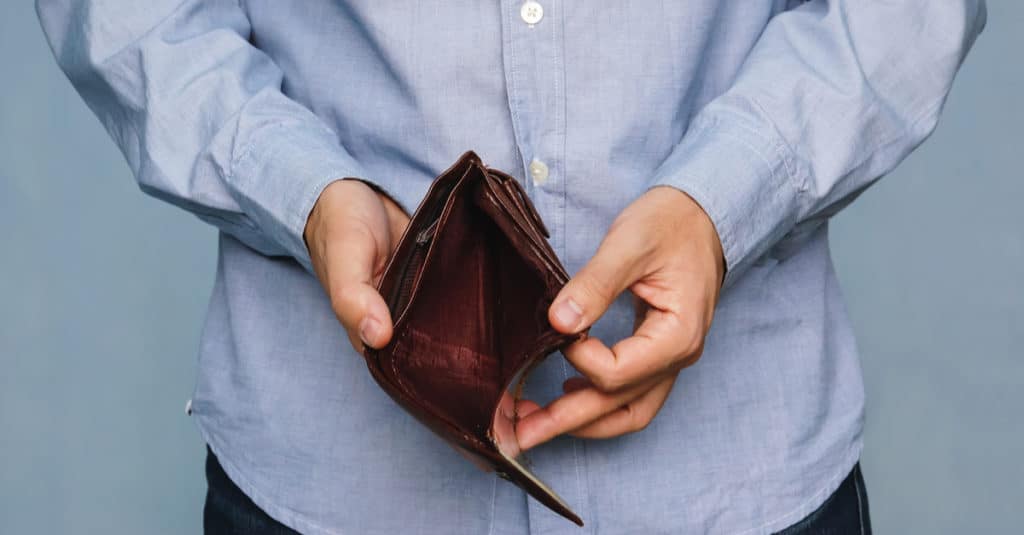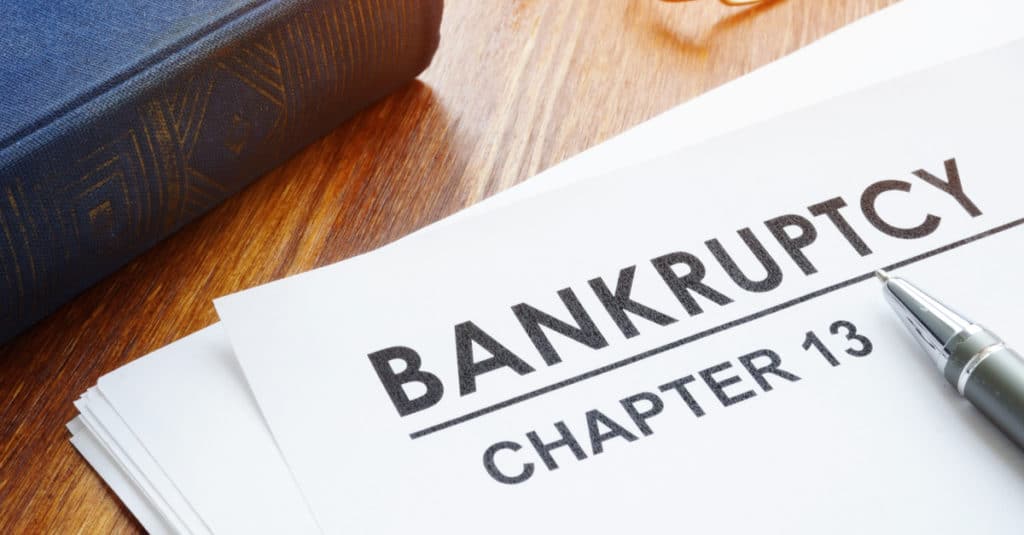When a person files for bankruptcy, their credit score dives. This makes it extremely difficult to qualify for most forms of new credit.
Most traditional lenders, including banks and credit unions, will reject applications for unsecured loans from consumers with bad credit or derogatory marks (ex., bankruptcy, charged-off accounts or accounts in collections) on their credit report.
The lenders who are willing to work with bankrupts usually charge origination fees, higher interest rates and other fees that other consumers don’t have to pay. As a result, many people who file for bankruptcy end up turning to predatory lenders who offer high-interest payday and installment loans at unreasonable rates.
Still, it isn’t all doom and gloom.
Table of Contents
Our take
There are two primary types of personal bankruptcy: Chapter 7 and Chapter 13. Both remain on your credit reports for several years.
You can increase your odds of having your loan application approved by applying with a co-signer, but if you don’t repay the loan, the co-signer will be on the hook to repay it.
There are other loan options after bankruptcy, including home equity loans and 401(k) loans. However, stay away from payday loans and tribal loans.
Are you eligible for debt relief?
We may be able to help if your bankruptcy has been discharged for 1+ years.
You can qualify for a personal loan after bankruptcy
There are reputable lenders willing to work with those with a less-than-stellar credit history. When making their decision, these lenders will consider other factors besides the consumer’s credit score or bankruptcy. These factors include:
- Type of bankruptcy (Chapter 7 or Chapter 13)
- Reason for filing for bankruptcy
- Borrower’s current credit score (this can improve over time)
- Borrower’s current income
- Any remaining debt
- Other financial obligations
Best personal loans for bankrupts
| Loan amount | Interest rate | Repayment terms | Minimum credit score | |
| Upgrade | $1,000 to $50,000 | 8.49% to 35.99% | 12 to 60 months | Not disclosed |
| Upstart | $1,000 to $50,000 | 7.8% to 35.99% | 36 or 60 months | 300 |
| CashUSA | $500 to $10,000 | 28% to 35.99% | 3 to 72 months | None |
| Avant | $2,000 to $35,000 | 9.95% to 35.99% | 12 to 60 months | 580 |
| OppLoans | $500 to $4,000 | 10.99% to 159.60% | 6 to 36 months | None |
| LendingClub | $1,000 to $40,000 | 8.98% to 35.99% | 24 to 60 months | Not disclosed |
| OneMain Financial | $1,500 to $25,000 | 18.00% to 35.99% | 24 to 60 months | None |
| Grace Loan Advance | $100 to $35,000 | 5.99% to 35.99% | 60 days to 72 months | Not disclosed |
| BadCreditLoans.com | $500 to $10,000 | 5.99% to 35.99% | 90 days to 72 months | Not disclosed |
| Personalloans.com | $500 to $35,000 | 5.99% to 35.99% | 90 days to 72 months | 580 |
Pro tip: Before you complete the official loan application, try to pre-qualify. This way you will have an idea of the loan term and interest rate without damaging your credit score with a hard inquiry.
Common eligibility requirements
These lenders usually have minimum eligibility requirements for their loan products, such as:
- Fair or good credit (580 to 739, according to Experian)
- Low debt-to-income (DTI) ratio
- Stable income
- Bank account
- Age 18 or up
Time has a significant impact on a person’s eligibility to qualify for a personal loan or other loan product as well. For example, a person who had their bankruptcy discharged or dismissed several years ago will have a better chance of qualifying for a personal loan than someone who still has an active bankruptcy case.
In general, the longer it’s been since filing for bankruptcy, the easier it is to find a lender with reasonable rates. This is especially true for those who’ve been actively working on improving their credit and financial situation since filing.
Chapter 7 and Chapter 13 bankruptcy
There are usually two filing options: Chapter 7 and Chapter 13. There are a few key differences.
Chapter 7 bankruptcy
A Chapter 7 bankruptcy is also known as liquidation bankruptcy, and it wipes away nearly all consumer debt, giving the individual a clean slate. However, Chapter 7 may result in the loss of certain assets like a home or your vehicle if you have a title loan. This type of bankruptcy stays on the individual’s credit report for up to ten years.
Chapter 13 bankruptcy
On the other hand, a Chapter 13 bankruptcy doesn’t necessarily wipe out the existing debt. Instead, the consumer must follow a 3- to 5-year repayment plan and make payments towards their creditors. Once this period is over, the remaining debt is cleared and the bankruptcy is discharged. Chapter 13 remains on the credit report for up to seven years. Most Chapter 13 filers won’t pay much toward unsecured debt, such as credit card balances, medical bills, and personal loans unless the unsecured debt falls into the priority debt category. (For example, child support or IRS obligations.) In those cases, you’ll pay the entire amount in full.
Regardless of the type of bankruptcy, it can be extremely difficult to qualify for any loan product. However, some lenders are more willing to work with people who’ve filed for a Chapter 13, provided they’ve followed their repayment plan.
Pro tip: Bankruptcy filings are complicated. Before taking any action you should consult a nonprofit credit counselor and a bankruptcy attorney (most places offer free initial consultations) to review your options before you make a decision on whether to file bankruptcy. The choices you make will impact your credit for as long as 10 years. It can also get expensive.
How long do I have to wait after bankruptcy to get a loan?
After filing for Chapter 7, you must wait at least four years after the court discharges or dismisses the bankruptcy to qualify for most conventional loans, and that’s only if you make on-time payments after exiting bankruptcy. Even then, many lenders will reject your application if the bankruptcy still appears on your credit report when they run a hard or soft inquiry.
The wait time also depends on the type of loan. For example, it may be possible to get a credit card relatively quickly after bankruptcy discharge. Since you can’t file for bankruptcy again for at least a few years after the previous one is discharged, this provides lenders more security that you’ll make payments to them.
If you’re trying to get a car loan through a subprime lender, you may be able to do so soon after bankruptcy as well. However, these loans typically come with unfavorable terms and high interest rates.
Finally, you may be able to get a mortgage loan, depending on the lender and the type of bankruptcy. Some FHA-insured lenders will work with borrowers while they’re still working on their Chapter 13 repayment plan. These lenders may also provide loans as soon as two years after filing Chapter 7.
Can a co-signer help me get a loan after bankruptcy?
If you do not qualify for a personal loan or other loan product on your own, you may have better luck with a cosigner or a guarantor. That’s because these act as a sort of assurance to the lender that you will repay what you owe.
What’s the difference? A cosigner would be held responsible for payments throughout the loan’s duration. A guarantor will be liable for the full amount if you default.
Anyone can be a cosigner, but the better their credit score, the better the rates for the loan. Ideally, the cosigner will have good or excellent credit (670 and up).
A guarantor must be a U.S. citizen, over age 21 and have excellent credit and a history of financial stability. It also helps if the guarantor is a homeowner.
Other options if you’ve been rejected
If you’ve been rejected for a personal loan, don’t immediately turn to payday loans for bankrupts. More than 90% of payday loan borrowers have ended up regretting taking out their payday loan. Instead, here are some alternative ways to help rebuild your credit and increase your chances of qualifying for a personal loan in the future.
Credit-builder loan
Credit-builder loans are a type of reverse loan meant for individuals who need to either build or repair their credit. Unlike with a traditional loan, the borrower does not receive the money for the loan upfront. Instead, the lender keeps the money in a secure account while the borrower makes monthly payments on it. Because of this, there isn’t usually a credit check.
As long as the borrower makes regular payments on an established payment plan, the lender will report their activity to the credit bureaus, thus helping them build credit. Once the borrower has paid off the loan balance (including any interest), the lender transfers the money over to them to do with as they see fit.
If you’re thinking about getting a credit-builder loan, check out these lenders:
| Loan amount | Interest rates | Repayment terms | Downsides | |
| CreditStrong | $1,000 to $10,000 | 5.85% to 14.89% | Maximum of five years | Setup fee, expensive monthly administrative fee |
| Self | $100 to $1,500 | Average of 15.65% | 12 to 24 months | One-time setup fee |
| MoneyLion | Up to $1,000 | Average of 29.99% | 12 months | Monthly fee |
Many banks, credit unions, and online lenders offer credit-builder loans. Before choosing a lender, consider the following:
- Loan terms, interest rates, and hidden fees
- Minimum and maximum loan amounts
- Cost of monthly payments
- Whether the lender reports to the credit bureaus
Cash advance app
Cash advance apps like Dave or Albert offer small, short-term loans and don’t charge interest. The advances are then repaid from your next paycheck. They don’t require a credit check, so they’re a good option for borrowers who’ve had to declare bankruptcy but need some quick cash in an emergency.
For example, Albert offers up to $250 until your next payday.
READ MORE: Best cash advance apps
Secured personal loan
A secured loan is another way for people to build credit, even after bankruptcy.
With a secured loan, the borrower must put up some form of collateral equal to or close to the amount of the money from the loan. However, if the borrower defaults on their loan, the lender can take the collateral to cover the deficit.
If you need to start building credit or increase your credit score, a secured loan is a good way to do it. Reputable lenders will report any payment activity on the loan to the credit bureaus, which helps build credit. Secured loans also have lower interest rates than traditional loans.
Secured credit card
With a secured credit card, the borrower puts up some form of collateral — usually a cash deposit — that serves as their line of credit. This amount is usually between $300 and $2,500.
Once the money is in the account, the account owner may then use the secured credit card like they would any other credit card. Any activity on the account is reported to the credit bureaus to help the consumer build credit.
Some financial institutions or online lenders offer borrowers the option to upgrade their secured credit card into an unsecured credit card for a higher credit limit. In both cases, the card will accrue interest if there’s a balance on it at the end of the month.
Peer-to-peer lending
Peer-to-peer (P2P) lending allows individual consumers to get loans directly from investors without using a third-party financial institution. P2P lending is a solid option for those who may not be eligible for traditional loan products but who still need to build their credit or secure financing.
Loan terms and rates vary across P2P platforms and websites since each provider sets its own loan rates and terms. However, these rates are almost always more reasonable than other short-term loans or payday loans for bankrupts.
There are several online platforms that offer P2P lending, such as Upstart, Peerform, Lenme, SoLo Funds and Lending Club. For those who prefer a more personal experience, the r/borrow subreddit also offers P2P lending.
Home equity loan
Home equity loans are secured by your home’s equity. Because your home is used as collateral, annual percentage rates are typically lower than those of personal loan lenders. If you’ve paid a significant amount of money toward your home, a home equity loan offers flexibility if you need help with debt consolidation post-bankruptcy. However, your home will be at risk if you can’t make the payments.
Stay away from payday loans
Payday loans seem like an easy option after bankruptcy. Payday lenders don’t check credit scores, and borrowers can have their money by the next business day.
There are approximately 23,000 payday lenders in the United States, but some states have banned payday lending. There are some good reasons for this. Payday loans are high-risk and come with a slew of problems.
For one thing, they have sky-high interest rates in the triple digits. For another, they have incredibly short repayment terms (usually two to four weeks). Due to these factors, many people who take out a payday loan can’t afford to pay it back on time.
Because of this, they end up taking out another payday loan to pay off the first. On average, payday loan borrowers take out 10 loans before they manage to get out of debt. This is what’s known as the payday debt trap and is the payday lending business model.
READ MORE: Payday loan consolidation can help you escape the debt trap
Pro tip: It’s even worse if the loan ends up being through a tribal lender that can sidestep state laws that cap interest rates. Many of these lenders charge annual percentate rates of 700% or higher.
The bottom line
Ultimately, there are several alternatives to payday loans for bankrupts, such as personal loans. If you don’t qualify right now for a personal loan or if the terms are unreasonable, consider getting a secured credit card, secured loan, or a cosigner for better rates. This will also help you rebuild your credit so you qualify for financing in the future.



